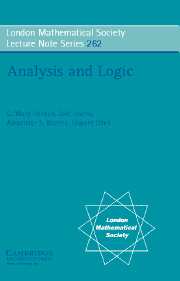Book contents
- Frontmatter
- Contents
- Preface
- Introduction
- Part One: Ultraproducts in Analysis
- Actions of Polish Groups and Classification Problems
- On Subspaces, Asymptotic Structure, and Distortion of Banach Spaces; Connections with Logic
- 1 Introduction
- 2 Background material: The 60's and 70's
- 3 The unconditional basic sequence problem and connections with distortion
- 4 Gowers' dichotomy: A block Ramsey Theorem
- 5 Distortion
- 6 Asymptotic structure
- 7 Ordinal Indices
- 8 The homogeneous Banach space problem
- 9 Concluding remarks
- References
8 - The homogeneous Banach space problem
Published online by Cambridge University Press: 05 May 2013
- Frontmatter
- Contents
- Preface
- Introduction
- Part One: Ultraproducts in Analysis
- Actions of Polish Groups and Classification Problems
- On Subspaces, Asymptotic Structure, and Distortion of Banach Spaces; Connections with Logic
- 1 Introduction
- 2 Background material: The 60's and 70's
- 3 The unconditional basic sequence problem and connections with distortion
- 4 Gowers' dichotomy: A block Ramsey Theorem
- 5 Distortion
- 6 Asymptotic structure
- 7 Ordinal Indices
- 8 The homogeneous Banach space problem
- 9 Concluding remarks
- References
Summary
We cannot end before at least briefly discussing one other spectacular result of the 90's.
We recall that the homogeneous Banach space problem (P5) is: If X is isomorphic to all Y ⊆ X, is X isomorphic to l2? This was solved by combining two beautiful pieces of work, Gowers' dichotomy theorem (Theorem 3.1) and the following theorem of Komorowski and Tomczak-Jaegermann [KT1, KT2]. A nice exposition somewhat simplifying the argument appears in [TJ1].
8.1 Theorem. If X is homogeneous and not isomorphic to l2 then X has a subspace without an unconditional basis.
It then follows that no subspace of X has an unconditional basis and so by the dichotomy theorem plus the fact that X is homogeneous we have that X must be H.I. But in view of the result of [GM1] that an H.I. space is not isomorphic to any proper subspace, this is impossible. Thus the solution of the homogeneous Banach space problem is achieved.
Komorowski and Tomczak-Jaegermann actually prove something stronger. They show
Theorem. Let X be a Banach space not containing a subspace isomorphic to l2. Then X contains a subspace without an unconditional basis.
Even more recently Komorowski and Tomczak-Jaegermann have made substantial progress on (Q4): if all subspaces of X have an unconditional basis is X isomorphic to l2? They proved [KT3].
Theorem. If every subspace of(X ⊕ X ⊕ …)l2 has an unconditional basis then X is isomorphic to l2.
The proof of Theorem 8.2 is well exposed in [TJ1] and we shall not repeat it here. It is interesting to note that spreading models enter at one part of the argument.
Information
- Type
- Chapter
- Information
- Analysis and Logic , pp. 252 - 253Publisher: Cambridge University PressPrint publication year: 2003
